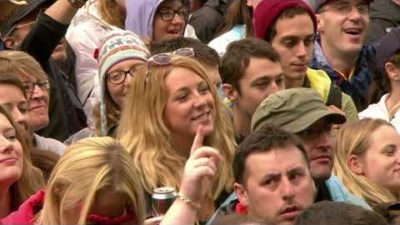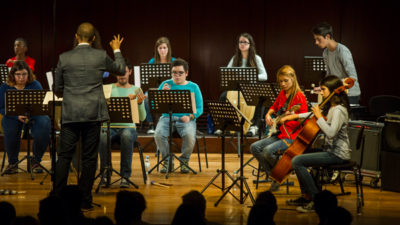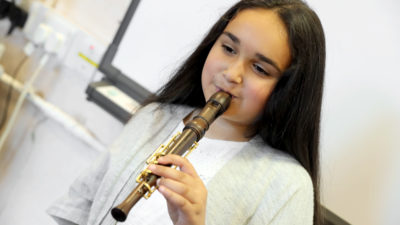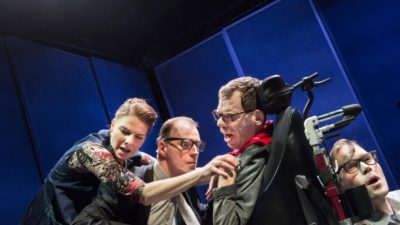Accessible Music Technology (AMT) is on the cusp of moving from holding a niche place within music-making to becoming a part of a bigger mainstream practice and disabled artists are at the forefront of creating innovative new ways of making music using technology.
This is a short film, lasting eight minutes, which explores three musicians’ experience of using AMT to enhance their music-making. The film follows Kris Halpin, John Kelly and Clarence Adoo as they talk about their individual approaches to music and explain how they use cutting-edge initiatives in AMT to create music and deliver live performances.
British Council – Three Adventures in Accessible Music Technology Full Audio Description Text
This is a short film, lasting eight minutes, which explores three musicians’ experience of using Accessible Music Technology (AMT) to enhance their music-making. The film follows Kris Halpin, John Kelly and Clarence Adoo as they talk about their individual approaches to music and explain how they use cutting-edge initiatives in AMT to create music and deliver live performances. This audio description of the film includes their spoken words and descriptions of their performances. It will take about fourteen minutes to listen to if read aloud.
The film begins with a montage of scenes in which the three musicians perform while their words are heard in voiceover. Kris Halpin first – he is making electronic musical sounds by making gestures with his hands wearing special Mi.Mu Gloves. He is standing in front of a huge projection screen, at Berlin’s MusicTechFest. Kris says: “I define AMT as being ‘Accessible Music Technology’; some people use the term Assistive Music Technology.” John Kelly comes next. John is filmed at an open mic event in a pub in London. He is strumming a guitar-like instrument, the “Kellycaster”, with other musicians around him. John says: “AMT is giving me a freedom and an equality with which to create music that is really important to me.” Last comes Clarence Adoo, who is controlling a computer-based musical instrument, HiNote, using a head-mounted ultrasonic pointer, at a contemporary music festival in Setúbal, Portugal. Clarence is surrounded by an ensemble of musicians in the open-air courtyard of a medieval monastery. He says: “Playing music and getting involved in music, thinking and breathing and concentrating in the same way I always used to, I am not aware that I am disabled.”
The film then fades to black to show the title in white lettering: Three Adventures in Accessible Music Technology.
Next, John Kelly address the camera directly from a room at home. Direct to camera at first, and then in voiceover, he says: “I’m John Kelly. I’m a musician, an artist and a disability rights campaigner. My music covers a few genres, but kind of folky, rocky, punky would be the three that best describe it.” Then we see John singing and playing the prototype Kellycaster with his friend Gary Day on conventional guitar. They are singing John’s version of a 1932 protest song “Which side are you on?” The film then cuts to the offices of Drake Music, an organisation specialising in AMT, and John’s voiceover continues: “I’m currently developing a guitar, the Kellycaster, because my left hand – I can’t do the finger shapes to play a chord. All I can really do at the moment is bar chord. And that’s quite limiting. So that’s where the whole kind of idea for the Kellycaster came along… I really just want to play guitar and sing with the guitar.” We see John at a workbench with colleagues from Drake Music, where they are experimenting with an adapted Fender Telecaster. John strums the current working version of the Kellycaster, which uses a Jamstick – an instrument that looks like the neck of a guitar with a separate electronic keyboard, both feeding into a computer. John says, as he strums out some guitar sounds, “Even that’s quite nice, just being able to give it a little bit…” He strums with his right hand and changes chords via the keyboard.
The film cuts away from John to Clarence Adoo who we see seated at his HiNote instrument: custom-designed software on a laptop which works with an ultrasonic pointer, which Clarence wears on his head, and a sip-puff mouth controller. The pointer allows Clarence to choose which note to play by moving a cursor around a honeycomb-shaped on-screen note selector; the software is pre-programmable with the instrumental mix each key produces; the mouth controller allows modulation of the note’s musical characteristics, such as attack, sustain or crescendo. Clarence plays part of a scale, then the film cuts to a new shot where he addresses the camera directly. He says: “My name is Clarence Adoo. I was a professional musician that played trumpet in all sorts of genres, and now, because of a car accident in 1995, I’m now paralysed from the neck downwards, and I now play an electronic instrument called HiNote. It’s basically like using one finger on a keyboard, which sounds very basic, but with the technology involved in these instruments it’s quite amazing.” There is a burst of music from the HiNote as Clarence plays some samples from a brass section. In voiceover he explains further: “The music that I play can be sort of very interestingly otherworldly, sounds that I move in different tempos and pulses, and can make you feel as if you are in a new space or on another planet really.”
The film cuts back to Kris Halpin. He is at work in a recording studio, standing to perform against a background of textured acoustic tiles. Microphones surround him; guitars and flight cases can be seen in the background. Kris is using the Mi.Mu Gloves – black, with a slightly military appearance. He moves both hands in a range of subtle and sweeping gestures. The gloves’ have built-in motion sensors that mean every hand movement can have a musical effect. Pre-programming the software allows specific movements to be read in a consistent manner: an air-punch to trigger a drum strike, for example. Kris addresses the camera directly: “My name is Kris Halpin. I’m a singer, songwriter, performer, producer, and I am known for working with the Mi.Mu gloves, which are a new kind of expressive bit of Accessible Music Technology to allow me to do things which I could never previously have done on stage due to my condition. I have cerebral palsy.”
In the studio, we hear more music and see the way Kris moving the gloves triggers different instruments’ joining the ensemble. Kris continues in voiceover: “I guess I would describe myself, in terms of musical genres, as a little bit of a kind of musical magpie. You know, if there’s one thing I feel that I’m good at, it’s writing songs. I don’t kind of feel any desire to be faithful to any genre at all. The gloves work with a number of things, so they have an accelerometer and a gyroscope, so they kind of know where they are in space.” Kris is talking to camera again now, wearing Mi.Mu gloves on both hands. He gestures to the back of his fingers on each hand and says, “And then here they have bend sensors; so then the shapes you make your hands into become part of how you express music. It’s quite abstract because you’re not actually looking at an instrument, it’s all just kind of the space around you.” The scene ends with a passage of music where Kris makes a variety of hand movements, and the relationship between these movements and changes in the music becomes clear.
The film stays with Kris as its subject now but changes location and cuts to an interview with a man who says: “I’m Andrew Dubber. I’m the Director of MusicTechFest. MusicTechFest is a festival of music ideas and what we call a giant creative laboratory.” The interview moves to voiceover and we see pictures of the festival in Berlin in May 2016. People mill around conference-style lobbies, and are seen handling items of music technology. The film cuts back to Andrew Dubber in interview: “One of the ideas that’s really important to us at MusicTechFest is the idea of accessibility to music performance.” The voiceover restarts now over shots of Kris on stage at the festival, performing in the Mi.Mu gloves, live, in front of an audience. This is the setting in which we saw Kris at the start of the film. Dubber’s comments continue: “I think that everybody should get involved with playing music. I think music should be play; I think music is something that everybody can participate in. I think that anybody who wants to play music should be able to play music. So removing barriers to participation is a really important thing for us. And obviously Kris is kind of, he’s a bit of a shining light in this territory because this is somebody who’s making genuinely, really good music, using music technologies in a way that we haven’t seen really before…”
The film cuts, briefly, to Kris in interview before going back to voiceover under his Berlin festival performance: “As a music fan growing up, music hit me in really profound ways, and I found myself hugely invested emotionally in my favourite artists and records. And I guess the dream is that you reach that point with people; and they see you that way and they have that connection with your music.” The live performance continues for a few seconds then the film cuts to a new scene.
The brightly lit exterior of a pub in London called ‘The Old Fields’. Laughter can be heard. Inside a man with a guitar, John’s friend Gary Day, approaches the microphone. He says: “Folks, next up in tonight’s show we have Mr John Kelly…” John is seated in his wheelchair to Gary’s left. “How are you?” says John and he whoops. Then we hear him in voiceover: “Tonight’s an open-mic night organized by my mate Gary. I’m down here just to sing a few songs.” Applause follows and John strums his guitar as a song begins. In voiceover again, John says: “I’m going to play a version of the Kellycaster tonight, with a different body. The body isn’t the Kellycaster, but the chord system, and what I’m doing, is very much in line with what the Kellycaster will be able to do. I’m just using elements of it, the rudiments of the Kellycaster.” There are shots of the audience drinking and enjoying the performance. John’s voiceover continues: “AMT is about freedom and it’s about equality. It doesn’t mean being the same as, because that’s not equality. Equality is being distinct and different, and being yourself, but on an equal footing.” The film cuts back to the performance as John plays and sings his song Battle of Whitehall: “Here we go… ‘Cause there’s a Battle in Whitehall – wooh-oh-ooh – and you’re in our sights.” The film shows the audience joining John to sing “wooh-oh-ooh”. John’s song continues: “There’s a Battle in Whitehall – wooh-oh-ooh – fighting for our civil rights…”
The film changes location to Portugal. A wide shot shows a blue sky and a sunlit city background, with a poster at the front-right announcing the “Festival de Musica, Setúbal”. There’s a cut to a bearded man in white suit and tie, who says: “I’m Ian Ritchie and I’m the Artistic Director of the Setúbal Music Festival in Portugal.” The interview moves to voiceover and the film shows pictures of the medieval monastery where the festival is being held. Then we see Clarence Adoo seated at his HiNote instrument among other performers in the monastery courtyard. The performance can be heard beneath the voiceover. The music is sophisticated modern jazz, atmospheric and bordering on the atonal. Ian Ritchie’s voice continues: “It seemed to me absolutely right that Clarence Adoo, as an extremely good professional musician, that he should be right there in the professional performing world, because there is such a powerful creative case for the use of new instruments.” There are close-ups of the screen of Clarence’s instrument while Ian Ritchie continues: “It seems to me that this is where perhaps the new frontiers can be pushed back for music itself.” The film shows Ian Ritchie listening to Clarence’s performance along with other members of the audience. Further shots of Clarence performing follow, then we hear Clarence in voiceover: “My HiNote instrument will be making its first trip onto the concert platform. I want the audience to be satisfied that they’re taken on a journey and that they’re probably hearing something new and different.” The music ends and a wide shot shows a rapturous reception from the audience. Someone calls out “Bravo!”
The film’s final sequence begins by returning to John Kelly’s performance at the London pub. He rallies several musicians together to finish a song. The audience applauds and the film cuts to John in interview. He says: “Music is really an equalizer. When we get the right resources to put it all together and make it truly accessible, that’s when the music is at its most beautiful and its most powerful actually, because it genuinely is about everyone in there owning it, being part of it, feeling it, belonging to it…”
Finally, the film cuts back to Kris Halpin in live performance at the Berlin MusicTechFest. We hear him in voiceover: “I do see that AMT has got really, really exciting, and really interesting in the last couple of years. Lots more kind of expressive things have come about, and certainly the gloves won’t be the only thing that’s that expressive. We are heading into very exciting territory.”
The final credits show a link to www.disabilityartsinternational.org.uk and the words “A Northern Town production for the British Council”. [ENDS]





